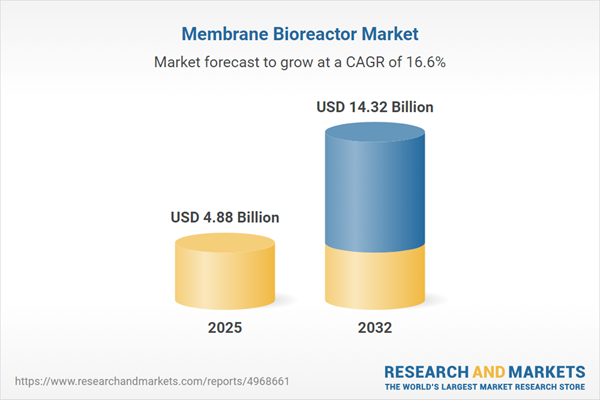Speak directly to the analyst to clarify any post sales queries you may have.
Membrane bioreactor technology is increasingly central to evolving water treatment strategies, offering senior decision-makers a robust solution that blends advanced filtration with proven biological processes. As organizations face rising regulatory pressures and sustainability demands, this approach fosters both operational adaptability and long-term compliance.
Market Snapshot: Membrane Bioreactor Market Size and Growth Outlook
The membrane bioreactor market reached USD 4.20 billion in 2024 and is projected to grow to USD 4.88 billion by 2025, with a CAGR of 16.55%. Looking further ahead, the market is expected to achieve USD 14.32 billion by 2032, as industrial and municipal sectors expand their adoption of this technology. Key growth drivers include heightened water quality requirements, complex regulatory changes, and a broad shift toward sustainable resource management. In response, organizations increasingly turn to membrane bioreactor solutions to address compliance mandates, improve water reuse, and streamline treatment operations across varied environments.
Scope & Segmentation of the Membrane Bioreactor Market
Comprehensive market segmentation supports informed decision-making by aligning technology selection with operational goals and site-specific demands. Each aspect of segmentation enables organizations to plan and deploy solutions that fit their technical and compliance requirements:
- Membrane Configuration: Selection between flat sheet, hollow fiber, or tubular membrane designs allows organizations to tailor filtration performance and infrastructure integration.
- Reactor Configuration: Options for submerged or external configurations enable adaptation for both new installations and upgrades to existing treatment plants, supporting diverse project needs.
- Membrane Material: Choices include ceramic materials such as alumina, titania, or zirconia for durability, and polymeric alternatives like PES, PSF, and PVDF for flexible, cost-effective deployment.
- Process Mode: Aerobic systems provide enhanced control over municipal water quality and nutrient removal, while anaerobic processes are leveraged in industrial sectors to reduce waste and recover energy.
- Capacity: Modular system sizes—from small to large—match a spectrum of plant scales, enabling operators to implement solutions for targeted upgrades or full-scale operation.
- End-Use Industry: Membrane bioreactors address compliance and productivity standards for industries such as chemical processing, food and beverage, brewery, dairy, oil and gas, pharmaceutical, pulp and paper, and municipal utilities.
- Installation Type: Flexible installation approaches allow deployment in both new build and retrofit scenarios, aligning capital planning with existing site conditions.
- Regional Coverage: Strategies are tailored to the Americas, Europe, Middle East & Africa, and Asia-Pacific, regions where differences in regulatory environments and infrastructure influence market dynamics and adoption rates.
- Key Companies Analyzed: Benchmarking innovations and commercial approaches from leading providers including EnviroChemie GmbH, General Electric Company, HUBER SE, Kovalus Separation Solutions, Mitsubishi Corporation, Newterra Corp., Nijhuis Industries, Premier Tech, Salher, Siemens AG, Smith & Loveless, and Veolia Environnement SA supports informed vendor selection and technology planning.
Key Takeaways for Senior Decision-Makers
- Membrane bioreactor systems are modular and scalable, making them suitable for gradual infrastructure adaptation as operational demands and compliance requirements shift over time.
- Investing in advanced digital monitoring and predictive maintenance underpins long-term system reliability and drives cost control throughout water management lifecycles.
- Close collaboration between solution providers and internal teams supports streamlined implementation and future expansion, reducing integration risks and downtime.
- Customizable system designs align water output quality with broader sustainability targets and organization-specific regulatory considerations.
- A deep understanding of regional regulations and infrastructure maturity allows operators to deploy tailored solutions and maximize system performance in diverse geographies.
- The integration of advanced digital tools supports real-time compliance tracking, further accelerating digital transformation initiatives within enterprise-level water operations.
Tariff Impact: United States Measures Affecting MBR Supply Chains
Recent U.S. tariff changes affecting membrane bioreactor components have prompted organizations to reassess sourcing strategies, encouraging greater supplier diversity and prioritization of regional vendors. This focus on procurement resilience enables companies to control costs, maintain steady supply lines, and respond effectively to new trade policies, ultimately supporting uninterrupted access to critical system parts.
Methodology & Data Sources
This analysis draws on executive interviews, thorough reviews of membrane bioreactor applications, regulatory assessments, and real transaction data. Data validation processes ensure that findings are both actionable and relevant to senior leaders responsible for procurement and risk management.
Why This Report Matters to B2B Leaders
- Facilitates effective capital planning and procurement decisions by translating complex technical and regulatory shifts into clear, strategic guidance.
- Provides actionable benchmarks and sector-specific best practices for improving operational efficiency within the membrane bioreactor market.
- Enables organizations to strengthen both supply chain and operational resilience amid fast-evolving market and regulatory landscapes.
Conclusion
Senior decision-makers can use these insights to shape adaptive, compliant water treatment strategies that keep pace with regulatory change while supporting core business objectives and long-term operational resilience.
Additional Product Information:
- Purchase of this report includes 1 year online access with quarterly updates.
- This report can be updated on request. Please contact our Customer Experience team using the Ask a Question widget on our website.
Table of Contents
3. Executive Summary
4. Market Overview
7. Cumulative Impact of Artificial Intelligence 2025
Companies Mentioned
The companies profiled in this Membrane Bioreactor market report include:- EnviroChemie GmbH
- General Electric Company
- HUBER SE
- Kovalus Separation Solutions, Inc.
- Mitsubishi Corporation
- Newterra Corporation
- Nijhuis Industries Holding B.V. by Saur
- Premier Tech Ltd.
- Salher, S.L.
- Siemens AG
- Smith & Loveless Inc.
- Veolia Environnement SA
Table Information
| Report Attribute | Details |
|---|---|
| No. of Pages | 187 |
| Published | November 2025 |
| Forecast Period | 2025 - 2032 |
| Estimated Market Value ( USD | $ 4.88 Billion |
| Forecasted Market Value ( USD | $ 14.32 Billion |
| Compound Annual Growth Rate | 16.5% |
| Regions Covered | Global |
| No. of Companies Mentioned | 13 |









